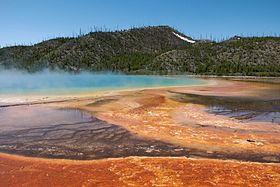Our website is made possible by displaying online advertisements to our visitors.
Please consider supporting us by disabling your ad blocker.
Geobiology

Geobiology is a field of scientific research that explores the interactions between the physical Earth and the biosphere. It is a relatively young field, and its borders are fluid. There is considerable overlap with the fields of ecology, evolutionary biology, microbiology, paleontology, and particularly soil science and biogeochemistry. Geobiology applies the principles and methods of biology, geology, and soil science to the study of the ancient history of the co-evolution of life and Earth as well as the role of life in the modern world.[2] Geobiologic studies tend to be focused on microorganisms, and on the role that life plays in altering the chemical and physical environment of the pedosphere, which exists at the intersection of the lithosphere, atmosphere, hydrosphere and/or cryosphere. It differs from biogeochemistry in that the focus is on processes and organisms over space and time rather than on global chemical cycles.
Geobiological research synthesizes the geologic record with modern biologic studies. It deals with process - how organisms affect the Earth and vice versa - as well as history - how the Earth and life have changed together. Much research is grounded in the search for fundamental understanding, but geobiology can also be applied, as in the case of microbes that clean up oil spills.[3]
Geobiology employs molecular biology, environmental microbiology, organic geochemistry, and the geologic record to investigate the evolutionary interconnectedness of life and Earth. It attempts to understand how the Earth has changed since the origin of life and what it might have been like along the way. Some definitions of geobiology even push the boundaries of this time frame - to understanding the origin of life and to the role that humans have played and will continue to play in shaping the Earth in the Anthropocene.[3]
- ^ "Life in Extreme Heat - Yellowstone National Park (U.S. National Park Service)". www.nps.gov. Retrieved 2016-06-04.
- ^ Dilek, Yildirim; Harald Furnes; Karlis Muehlenbachs (2008). Links Between Geological Processes, Microbial Activities & Evolution of Life. Springer. p. v. ISBN 978-1-4020-8305-1.
- ^ a b Cite error: The named reference
:6was invoked but never defined (see the help page).
Previous Page Next Page


